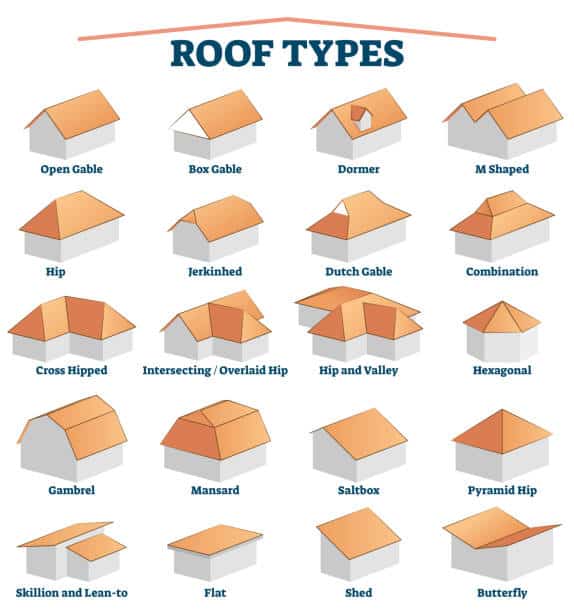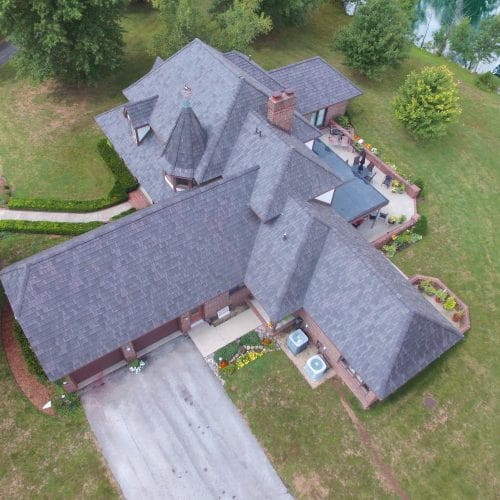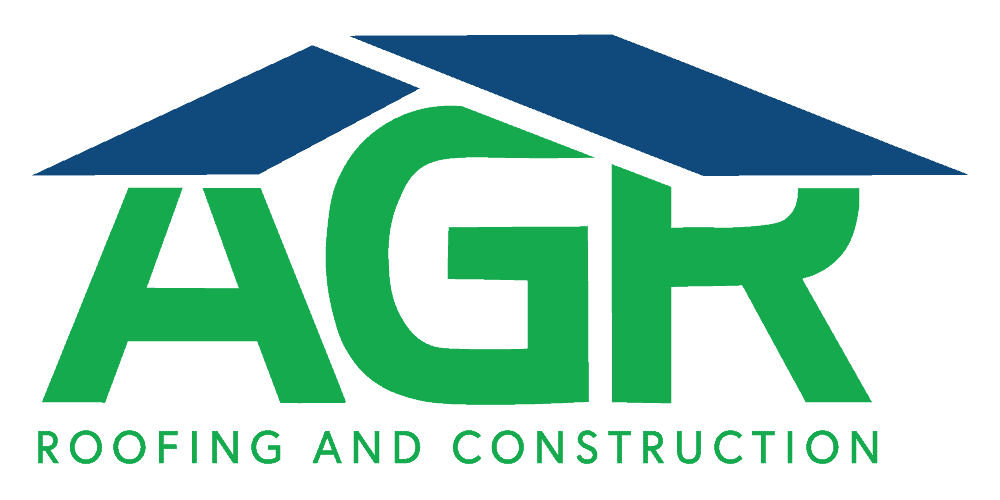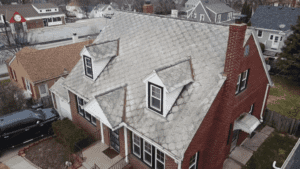Have you realized how much roof design and style affect a home’s entire look? How much charm would the quintessential cottage have without a thatched or stone roof? Would the Sydney opera house be instantly recognizable without its world-famous winged shell roof?
Roofing choice is far more impactful than the siding, window treatments, or landscaping. Altering its structure and covering materials impacts the building’s fundamental appearance.
Roofing design is all about the slope, along with the intersection of planes and angles. Once that’s done, it’s time to add texture, patterns, color, and other visual interest elements with the perfect roofing material.
8 Popular Roofing Styles

1. Gable Roof
A gable roof in its simplest form has two sloping roof planes that meet along the top to form a ridge. It’s the classic A-shaped triangular roof. The interior space underneath it is perfect for a small attic living space.
Gable roof variations include clipped, cross, side, and Dutch gable roofs.
· Clipped Gable: the top peak is bent inward to create a flat hip at the end
· Cross Gable: two or more intersecting gable rooflines that flow with the house’s structure
· Dutch Gable: combines gables and hips, usually with a gable sitting on top of a roof hip
Ideal Gable Roof Materials:
· Asphalt Shingles
· Clay or Concrete
· Slate
· Wood
· Almost any other
2. Gambrel
This is the classic barn roof shape. It’s a two-sided roof where each side has two slopes: a short and shallow top slope connected to a steep longer bottom slope.
Windows can be added along the steep top slope to bring in plenty of light. This makes gambrel roofs ideal for a full upper living space.
Ideal Gambrel Roof Materials:
· Wood shake or shingles
· Asphalt
· Synthetic shingles
· Metal
3. Hip Roof
A hip roof has four sloping sides that meet to form a ridge. This lacks the flat siding face found with gables or gambrel roofs. The top of the house is all roofing material in a pyramid-like shape.
Hip roofs are often found on bungalows or houses where the layout can’t support a gable roof.
This is the second more common roof design. Hip roofs are more complicated to build than gable roofs but are also more stable.
Ideal Hip Roof Materials:
· Asphalt
· Slate or Stone
· Clay or Concrete
· Wood
· Synthetic
4. Mansard
A mansard roof combines a hip roof’s structure with the gambrel’s design. It has four sides that each have two sloping planes which can either be flat or curved.
This originated in France and gives homes a very charming old-world look.
Ideal Mansard Roof Materials:
· Slate
· Asphalt
· Wood
· Synthetic and other
5. Shed
A shed roof is a single, flat sloping roof. A shed roof can be used on its own or in combination with other styles, like flat surfaces. This is best for modern, architectural aesthetics.
Ideal Shed-Style Roofing Materials:
· Metal
· Wood
· Concrete
6. Jerkinhead
A jerkinhead roof combines hip and gable elements to form a complex, architectural structure. Jerkinhead may sound strange, but this is a classic roofing design that’s been in use since at least the 15th century.
These roofs are strong with a timeless look. It’s used on churches, along with Craftsman cottages and Queen Anne-style homes.
Ideal Jerkinhead Materials:
· Asphalt
· Synthetic
· Wood
· Slate
7. Butterfly
A butterfly roof has two sloping sides which angle downwards to the home’s center. It’s an architectural favorite that inverts the traditional roofing form.
These roofs are ideal for getting high amounts of light and ventilation. However, butterfly roofs built in wintery climates must have enough central support to carry high snow or water loads.
Ideal Butterfly Roof Materials:
· Metal
· Asphalt
· Slate
· Concrete
8. Low Slope or Flat
Flat roofs look and feel utilitarian. However, they can also give residential homes a modernistic appearance.
This roofing style is often used in combination with other styles, like hip roofs. They can also be used to support rooftop living spaces.
Ideal Low or Flat Roof Materials:
· Rolled roofing (MSR) – only suitable for low slope, not flat
· Rubber roofing membrane
A Quick Guide to 10 Commonly Used Roofing Materials
1. Asphalt Shingles
Asphalt shingles are energy-efficient, durable, and suitable in just about every climate. Plus, these shingles are a classic roofing choice that appeals to both conservative and bold tastes.
You really can’t go wrong with most asphalt products. However, different types are appropriate for certain regions.
There are two types of asphalt shingles:
· Organic: asphalt-soaked felt or cellulose material is compressed and coated in a final asphalt or ceramic layer
· Fiberglass: glass fibers are soaked in asphalt and compressed, then coated in a final asphalt or ceramic layer
Organic asphalt shingles are algae-resistant, more durable, and better for cold harsh climates. However, they’re quite heavy and cost more.
Fiberglass asphalt shingles are more fire and heat-resistant than organic shingles. They’re also lighter and cost less.
Asphalt shingles come in three styles, giving very different appearances.
· Strip or 3-Tab Shingles: the cheapest option gives a basic, traditional flat shingle appearance
· Dimensional or Architectural or Laminated: two or more asphalt layers are layered together, looking more like wood or slate
· Luxury or Premium: made of asphalt blended with other materials, for a weighty and natural appearance
Manufacturers produce these styles in a variety of colors and patterns. If you prefer this roofing material, there’s bound to be a design you like.

2. Clay Tiles
Clay is molded and baked under pressure to form roof tiles. Clay tiles are naturally fire-resistant, wind-resistant, and long-lasting (as in hundreds of years long).
Terracotta isn’t the only clay option available now, as these tiles are now manufactured in different colors and styles.
Clay Tile Pros:
· Low maintenance and durable
· Eco-friendly material
· Lasts long enough to make a higher initial cost worth it in certain cases
· Naturally energy efficient
· Doesn’t rot or decay
· Impervious to insect infestations
· Recyclable after use
· Doesn’t absorb much water
· Maintains its color
Clay Tile Drawbacks:
· Can cost around $10 to $12 per square foot, more for fancy options like terracotta
· Heavy enough to be expensive to ship
· Too heavy for certain roofing structures or houses
· Prone to cracking in cold weather
· Brittle and impact vulnerable
· Tricky to install
· Can’t be used on all roof slopes
3. Concrete Tiles
Concrete tiling is a similar option to clay. It’s made from sand, cement, and water that’s molded and baked under pressure.
Concrete Tiling Pros:
· Fire and wind resistant
· Comes in different sloping styles
· Can simulate other materials
· Quite inexpensive
Concrete Tiling Cons:
· Pigments and surface paint fade over time
· Concrete absorbs water unless protected, leading to mold, mildew, and algae
· Easily damaged on impact
· The underlayment will need replacing before the tiling does
4. Metal Roofing
Metal roofs are no longer reserved for industrial use only. There are plenty of residential-style options available and these products are increasingly popular.
Metal roofs can be made from tin, aluminum, zinc, steel, or corrugated metals.
Most still come in sheets, but with patterns that add visual interest. Some are wavy or angular with the appearance of individual tiling. Others are lined, crisp, and architectural.
Metal Roofing Pros:
· Snow, ice, and rain slip right down
· Can last 50 years and up
· Very lightweight, only 1 to 3 pounds per square foot
· As quiet as shingles when installed correctly
· Eco-friendly made from recycled material and able to be recycled post-use
· Can go on low pitches
Metal Roofing Cons:
· Can’t be used on flat pitches
· Can dent on impact
5. Stone-Coated Steel
Stone-coated steel brings the strength and durability of metal with the traditional style of natural stone. It’s the perfect way to elevate a home’s appearance without ramping up the costs.
This roofing material is available in traditional-looking shingles, wood shake, clay tile, and barrel tile styles.
Stone-Coated Steel Pros:
· Far lighter than solid stone
· More energy-efficient than asphalt
· Around the same price as metal roofing
Stone-Coated Steel Cons:
· More expensive than asphalt
· Paint coating eventually wears off
· Installing on high-pitched roofs can be difficult
6. Slate Tiles or Shingles
Slate shingles or tiles are composed completely of natural, quarried stone with no mixing, binding, or layered manufacturing involved.
Slate brings an elevated, elegant appearance, making this a popular choice for executive and high-end homes.
Slate roofing is made from either hard or soft slate varieties.
Hard Slate:
· Lasts 75 to 200 years
· Colored slates are usually hard
Soft Slate:
· Lasts 50 to 125 years
· Black colored slates are usually soft
Slate Roofing Pros:
· Virtually impervious to moisture
· Fireproof and heat resistant
· Can be recycled and reused
· Insect and pest impervious
· Elegant aesthetic
Slate Roofing Cons:
· Extremely heavy
· Can be brittle and impact vulnerable
· Difficult to install and requires an expert roofer
· Premium material with a premium price
· No material warranty since it’s a natural product
7. Wood Shake and Shingles
Wood shakes are thicker, rougher in texture, uneven, and look quite rustic. Wood shingles are thin, smooth, uniform, and have a more refined appearance.
Cedar makes the best wood roofing product, as it’s moisture-resistant, rot-resistant, and easily found. Other options include redwood, teak, and pine.
Wood Roofing Pros:
· Last up to 30 years
· Biodegradable and renewable
· Thicker wood shake is more durable
· Natural insulation that balances the home’s temperature
· Performs well in cold and warm weather
Wood Roofing Cons:
· Can discolor
· Vulnerable to pests without treatment
· Inherently vulnerable to fire
Wood roofing tiles come in three types of graining: edge, flat, or slash. Edge grain is the most durable, so always choose this option if you want a wood roof. Slash grain is the least durable and poorest quality, so make sure to skip it.
8. Synthetic or Composite Shingles
Synthetic shingles give the look of slate, wood, or clay with less weight and maintenance. Composite shingles are made from recycled materials, natural-synthetic mixes, or entirely from engineered polymers.
You can also find synthetic asphalt alternatives engineered to be granule-less with higher performance.
Synthetic Shingle Pros:
· Mimics just about any other roofing material
· Can last up to 100 years
· Can be made with ultraviolet inhibitors
· Can be built storm resistant
· Imitation clay or terracotta can be used in cold climates
Synthetic Shingle Cons:
· Pricier than standard asphalt shingles
· Fire rating and storm resistance can vary
Synthetic quality varies. It’s all about the manufacturer with this option, so make sure to purchase products from one with an outstanding reputation. It’s a good idea to ask a professional roofer for their recommendations here.
9. Rubber Slate
You can get the slate look made entirely from lighter recycled rubber and plastic. Rubber slate is an interesting synthetic option that looks exactly (or almost exactly) like natural slate.
Rubber Slate Pros:
· Great for complex roof structures with many plane intersections
· Lasts up to 100 years
· Lighter than asphalt and slate
· Great weather performance
· Hail and impact resistant
· Absorbs ultraviolet rays without deteriorating
Rubber Slate Cons:
· More expensive to install than asphalt
· Easily damaged by fires
· Limited color options
· Can smell like tires when first installed
Rubber slate is durable, as tough as tires, and an eco-conscious recycled choice. But it isn’t naturally fire-resistant, can initially smell off-putting, and isn’t ideal for all homeowners.
If you want to help divert tires from landfills, this might be the perfect slate alternative. Otherwise, check other synthetic options.
10. Rolled Roofing (MSR)
Rolled roofing is a mineral-surfaced asphalt-based material that comes in a roll. It’s rarely used solely for residential homes but can be useful if the roof has flatter sections.
Rolled Roofing Pros:
· Very inexpensive
· Easy to transport and install
· Ideal for low-sloped roofs
Rolled Roofing Cons:
· Unattractive enough to be banned by some HOAs
· Only lasts 5 to 8 years
· Less durable than shingles
Find Your Perfect Roof
The roof makes up 40% of a home’s visual space. And it can deliver far more visual interest than the outer walls, siding, and windows.
Want to turn your home into a showcase and outdo your neighbors on curb appeal? Find the right architectural roofing design and finish things off with an elevated roofing product.
Contact AGR Roofing and Construction for a look into the latest roofing styles, tips on what manufacturers can really deliver, and consultation on what’s appropriate for your home’s structure.





